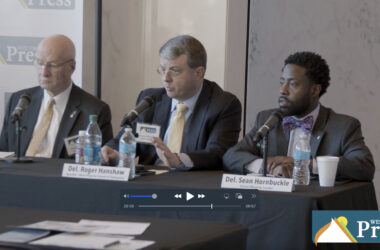By RUSTY MARKS
The State Journal
CHARLESTON, W.Va. — Throughout his campaign and during his inaugural address, Gov. Jim Justice talked about his idea to create a state timber industry to help make up for the losses in revenue from the Mountain State’s coal, oil and gas industries.
With about 77 percent of the state covered in forest, many people think it makes a lot of sense to take advantage of West Virginia’s timber resources. But what would Justice do to encourage the growth of the timber industry in the state? What can be done to attract sawmills and processing plants and furniture manufacturers to West Virginia?
While he was on the campaign trail, Justice fielded criticism that many of his big ideas lacked structure or detail. Gubernatorial spokesman, Grant Herring, said Justice has put a lot of thought into growing the state’s timber industry.
To spur growth, Herring said the governor would:
• Create a Workers’ Compensation insurance risk pool for loggers to reduce their premiums;
• Pursue investment in biomass energy plants;
• Encourage the Environmental Protection Agency to classify biomass as carbon-neutral — something the agency currently is considering, which would promote biomass energy development;
• Finish Corridor H to reduce transportation costs and provide easier access to East Coast markets and ports;
• Link biomass and coal power plants to make both more viable;
• Help companies market their products for export and to domestic customers;
• Promote additional forestry training courses at community colleges;
• Connect logging operations to existing industry to recycle their excess heat production to run lower cost dry kilns so that more timber can be processed locally; and
• Push for a federal subsidy that would support hardwoods manufacturing.
“Gov. Justice understands how to leverage our trees into new job opportunities,” Herring said. “He sees an opportunity to create new jobs by adding mills and hardwood manufacturing operations to West Virginia. It means lower transportation costs.
“West Virginia has 12 million acres of prime hardwoods,” he added. “Nearly 80 percent of the state is forested, and West Virginia’s forests are growing 2.5 times faster than current timber harvesting. The forest and wood products industry currently employs almost 15,000 West Virginians, contributing $2 billion to our economy.”
Herring said the Mountain State currently has many unforested plots of land that could be rehabilitated to become productive.
“Healthy forests mean more tourists and hunters, bringing jobs to our state,” he said.
Will it Work?
Joe McNeel, director of West Virginia University‘s Appalachian Hardwood Center, said Justice’s ideas make a lot of sense. The center was set up in 1987 “to provide technical and research support for the state’s growing wood products industry,” according to the hardwood center’s website.
“They’ve thought this out,” McNeel said after looking at several of Justice’s timber proposals.
“We are the third-most forested state in the United States right now,” McNeel said.
He said “there’s a reason” Justice is interested in making timber into a more viable state industry.
McNeel agrees something needs to be done to help loggers meet their workers’ compensation premium requirements. For every dollar loggers currently spend on payroll to their employees, McNeel said, company owners have to pay between 65 cents and $1 on workers’ Compensation premiums.
Under current requirements, McNeel said there’s little incentive for those in the timber industry to try to expand, because their premium costs go up with each new employee.
“If you’re a small business and you’re trying to grow, you’re going backwards,” he said.
McNeel also likes the idea of utilizing biomass.
In the case of logging, biomass is the branches and detritus from cutting down trees that aren’t usefu, but biomass can be used for fuel to supplant coal in the generation of electricity or turned into biofuel. Provided the EPA agrees to classify biomass as a carbon-neutral energy source.
Officials with EPA have been debating whether or not to do just that. McNeel believes there is a good chance biomass will be classified as carbon-neutral, especially under the administration of President Donald Trump.
Justice also wants to work with federal officials to create a federal subsidy for timber products.
See more from The State Journal





